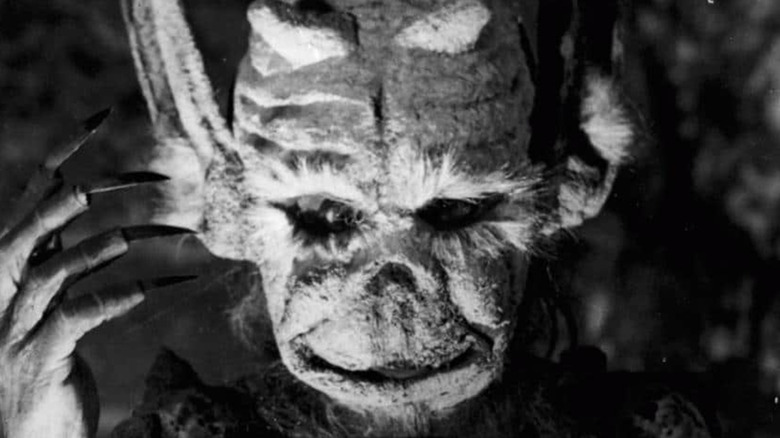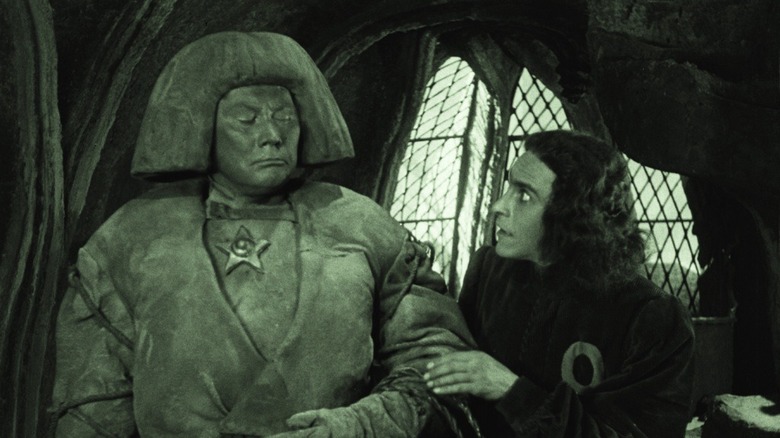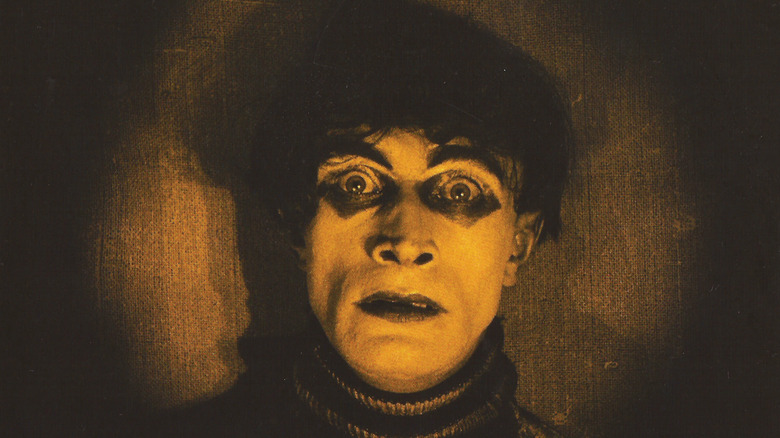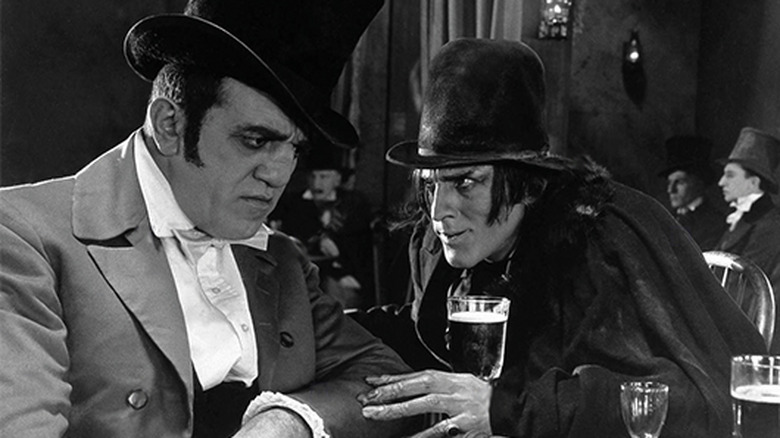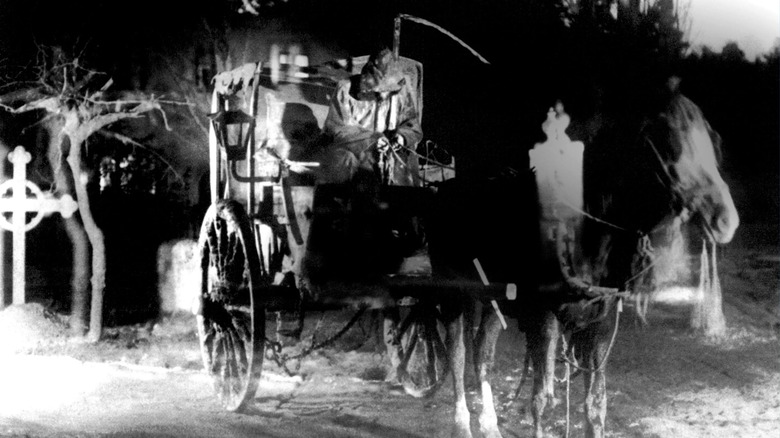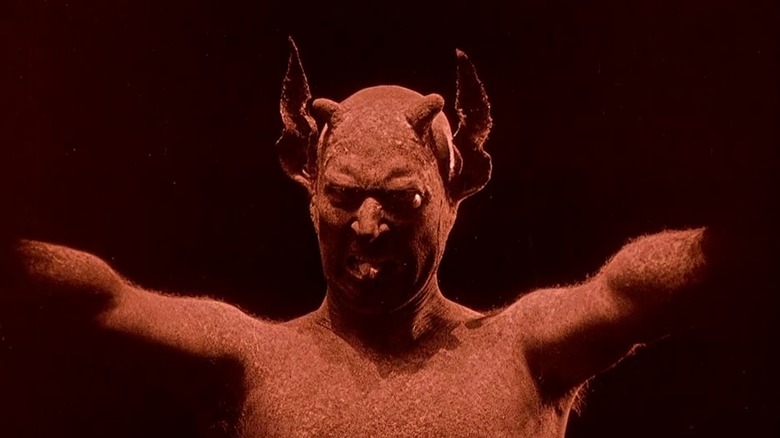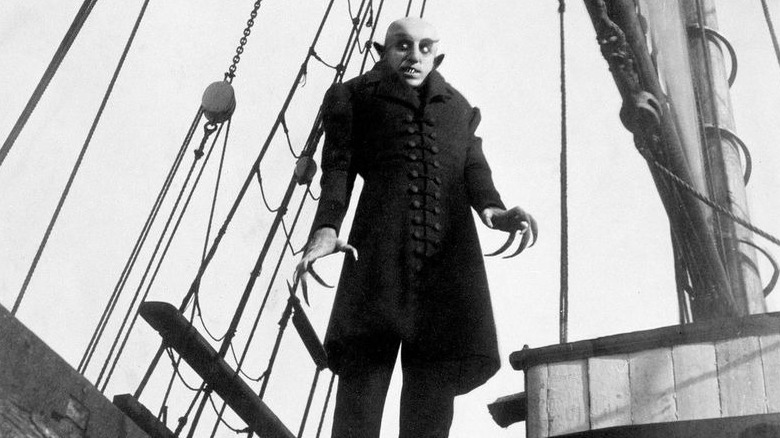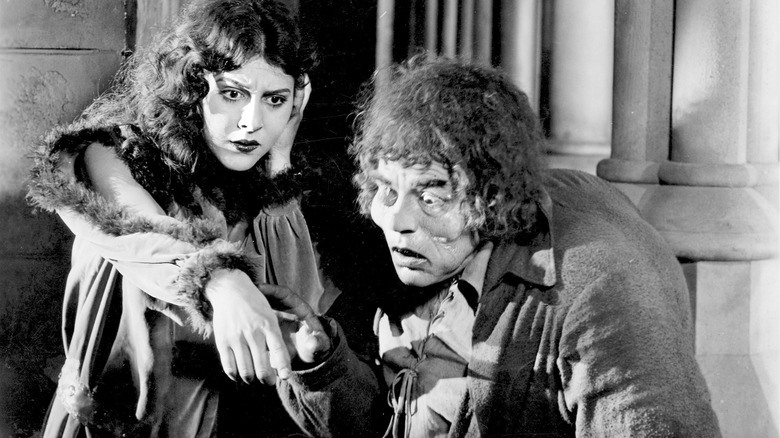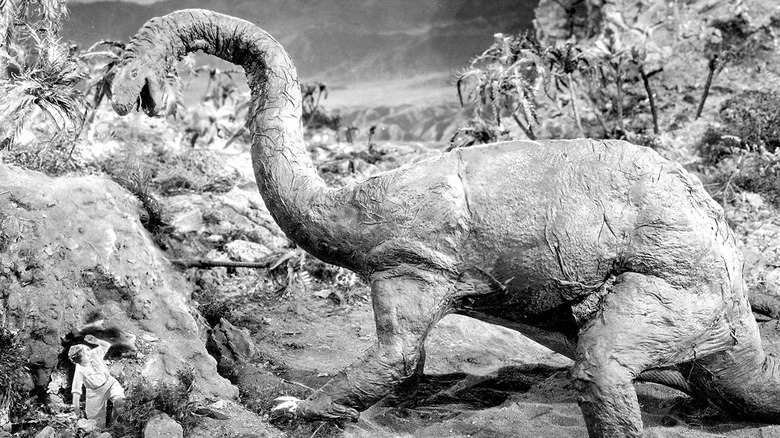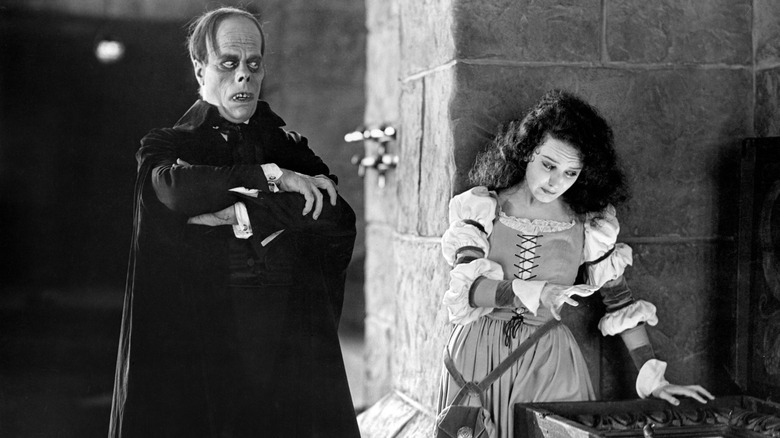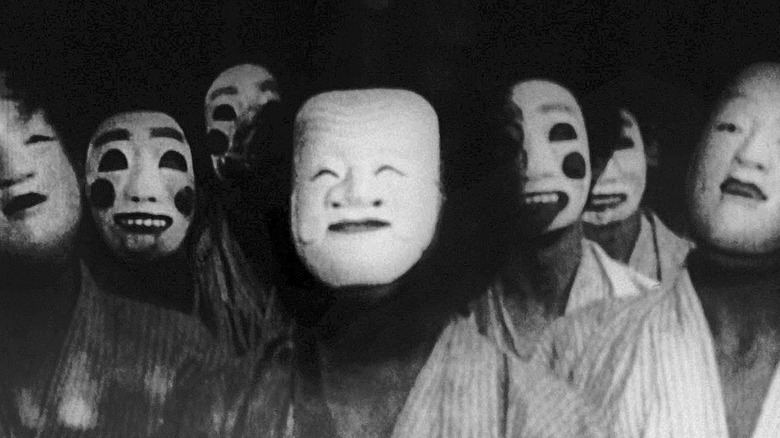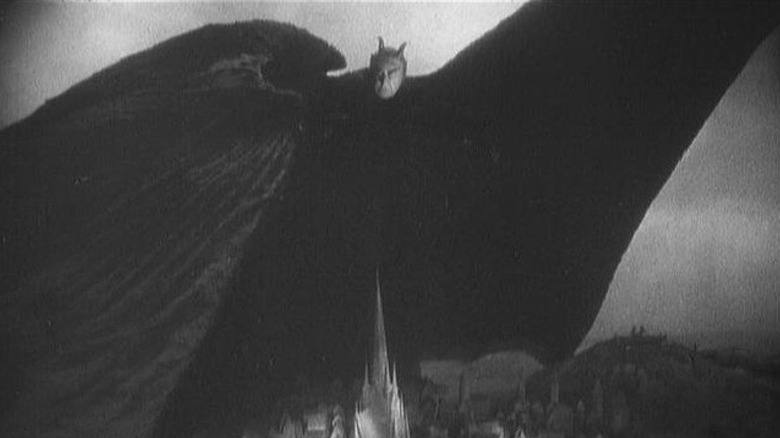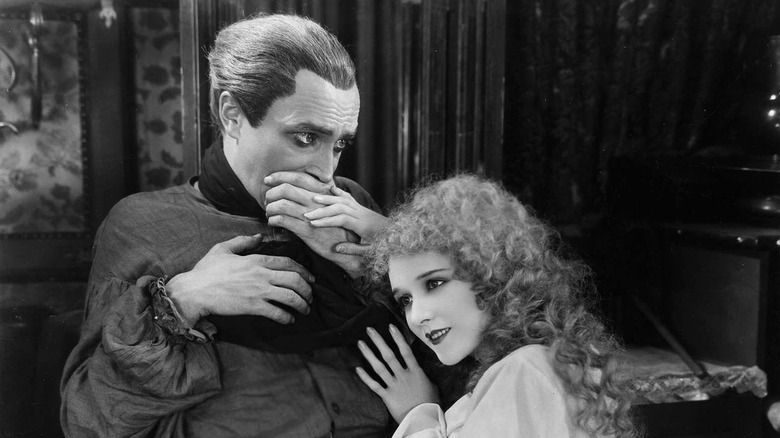Silent Horror Movies That Will Give You Nightmares
The horror genre has been leaving moviegoers with goosebumps since filmmaking's most formative years. Long before the advent of sound-related technology, movies were a silent medium bolstered only by visuals and music. Silent horror cinema possesses a level of subtlety and dread that has gone unmatched by modern filmmaking. In place of excessive gore or heart-rattling jumpscares are steadily built atmospheres and surreal, often nightmarish, visuals.
Given the age of many of these films, some close to 100 years old, it is to be expected that many still remain lost. However, many significant silent horror films have survived the sands of time, and remain as artifacts of essential horror history. From old folklore to German surrealism to literary monsters, these flawless horror films ran a wide gamut in terms of influence and style. So grab some popcorn and turn off the lights, because these are some silent horror movies that will give you nightmares.
The Golem: How He Came into the World (1920)
The idea of a golem has been a popular part of Jewish folklore for hundreds of years, and still endures even today (via Jüdisches Museum Berlin). One legend that has proven to be most widespread centers around Judah Loew ben Bezalel, a 16th-century Rabbi who resided in the city of Prague. Legend has it that Judah created the golem out of humble clay to protect the Prague ghetto from persecution. This is the narrative presented in the 1920 silent horror film known as "The Golem: How He Came into the World." The film itself was actually the third film in a trilogy, serving as a prequel for a larger narrative. The other two films are both lost to varying degrees, leaving this installment as the only one that's survived in its entirety (via University of Graz, Austria).
Just as it's described in the legend, Rabbi Loew, predicting tragedy for the people of Prague, begins crafting a way to protect his people. To achieve this, he sculpts the titular golem out of clay who then comes to life to fulfill his role as a protector. "The Golem" holds an important place in film history, given its status as the earliest film to feature a man-made monster — long before the Frankenstein monster (via BFI).
The Cabinet of Dr. Caligari (1920)
One cannot talk about silent horror cinema without discussing the German expressionism movement of the early 1900s. The style — most prevalent from the 1910s to the 1930s — was predicated on representing feelings more so than reality. This was often expressed through painted dreamlike visuals which utilized heavily distorted shadows and weird, angular, often colorful shapes (via MasterClass). "The Cabinet of Dr. Caligari" has been hailed by many critics, including Roger Ebert, as one of the first true horror films.
We are introduced to Francis, who regales a stranger with the story of an ordeal that he and his now mentally-frayed fiancée Jane had been through. He tells the story of how he witnessed a bizarre public spectacle courtesy of a mysterious doctor by the name of Caligari. The sinister doctor presents a gaunt somnambulist — a sleepwalker — named Cesare, who can seemingly predict the future at Caligari's command. Soon enough, it's revealed that Cesare is a murderous monster at Caligari's control, and he soon goes after Jane. The entire film you'll find yourself falling under the film's spell, aided in no small part by its eye-catching expressionist visuals. Everything from the windows to the streets to the shadows all have a surreal and distorted quality to them, which only adds to the film's disorienting presentation. Despite being over 100 years old, "The Cabinet of Dr. Caligari" is still an effectively atmospheric, visually distinct, and unsettling watch.
Dr. Jekyll and Mr. Hyde (1920)
Robert Louis Stevenson's 1886 novella "The Strange Case of Dr. Jekyll and Mr. Hyde" is often regarded as a seminal work of horror fiction. Its influence has been undoubtedly widespread, worming its way into countless other works — including comic books like "The Incredible Hulk." The story of Dr. Jekyll and his sinister alter ego, Mr. Hyde, has been portrayed on screen a multitude of times, and in radically different ways. The story can easily be reconfigured for any time period as the story of good, evil, and human duality will always make for an interesting narrative. This includes one of the most famous versions, originally released in 1920 and starring John Barrymore as the titular dual characters.
While this version isn't a fully accurate adaptation of the story, it does provide an effectively sinister version of Mr. Hyde. John Barrymore's portrayal is nothing short of disturbing, helped immensely by his naturally expressive face working in tandem with some mild makeup enhancements. Whenever Barrymore stares down the lens of the camera with his off-putting beady eyes, it evokes such palpable dread. In fact, per an archived review of the film in Photoplay Magazine, many were worried that his performance was so terrifying it would prove unhealthy for expecting mothers. There have been many other versions of Stevenson's haunting tale of science gone wrong, but this early silent version still stands out as one of the finest.
The Phantom Carriage (1921)
For this next selection of silent screams, we're taking a jaunt over to the country of Sweden in the early 1920s. "The Phantom Carriage," directed by Victor Sjöström, is based on the 1912 novel "Thy Soul Shall Bear Witness!" by Selma Lagerlöf. The film follows a boozer named David Holm who, after an ill-timed fight, dies just as the clock strikes 12 on New Year's Eve. Now, as the legend goes, he must drive Death's carriage and collect the souls of the dead for the following year. It's here that David is shown key moments of his former life, and certain key decisions he could've made differently.
The film is, at its core, a fantastical morality tale that utilizes horror elements to convey its themes and ideas. Given its haunting visuals, and its bizarre non-linear plot, the film has been praised for its level of cinematic influence (via PopMatters). If you are looking for a film that'll leave you with goosebumps and some interesting questions, definitely take a ride on "The Phantom Carriage."
Haxan (1922)
"Haxan" is yet another example of Swedish horror, and an example of how even early filmmakers would push the envelope. The film is a bizarre beast, as it switches between fictional narrative bits, and documentary-style segments — both focused on the "facts" and folklore concerning witchcraft.
The documentary segments are a bit slow at times, but contain some interesting facts regarding witches and Satan worship. These segments pair nicely with the narrative segments which see dramatizations of the previously mentioned information, shown through horrific visuals, many of which still hold up today. These visuals include grotesque-looking demons, and even a depiction of Satan himself, played by the film's director Benjamin Christensen.
To have this level of rampantly satanic images, including some nudity, back in the 1920s was quite the artistic gamble — truly a risky cinematic endeavor. One hundred years later, and the film is oft-regarded as a stylistic trend setter, especially through its then-unique format (via PopMatters). Any film that uses documentary segments to further a fictional narrative owes almost everything to "Haxan."
Nosferatu (1922)
Certain horror films transcend simply being memorable and achieve a level of influence that can stand the test of time. This is the case with F. W. Murnau's "Nosferatu," released in 1922, one of the earliest onscreen depictions of a vampire. The film is a loose adaptation of Bram Stoker's "Dracula," with key details changed to avoid any legal conflict with Stoker's widow (via Den of Geek). This meant that Count Dracula was renamed and remodeled into a variant known as Count Orlok, played by Max Schreck. "Nosferatu" follows Thomas Hutter, who travels to Transylvania to secure the signature of Count Orlok, who seeks a house across from Hutter's own residence.
Soon enough, Hutter's wife finds herself in Orlok's sinister crosshairs, and Hutter must race against the clock to save his beloved. This is a true chiller in every sense of the word, with every scene just oozing an unsettling and forbidding mood. From Count Orlok rising from his coffin to his sinister shadow cast along the wall as he climbs the stairs, the film is loaded with iconic imagery. To this day many critics still hail "Nosferatu" as a legendary classic of the horror genre, and it isn't hard to see why.
The Hunchback of Notre Dame (1923)
It couldn't be a list of nightmare-inducing silent horror cinema without discussing the man of a thousand faces, Lon Chaney. Chaney's now-legendary grasp of physical language and masterful facial expressions originated out of familial necessity, as both of his birth parents were deaf (via Colorado Springs Pioneers Museum). This command of physical performance, along with his skill with theatrical makeup, helped to propel him into the limelight. Cheney soon became best known for his on-screen portrayals of physically deformed, often misunderstood misfits such as Quasimodo in "The Hunchback of Notre Dame."
The film, while not the first, stands as one of the most famous adaptations of Victor Hugo's famous 1831 novel. For such an early film production, everything in it feels grand in scale — especially the sets, which all perfectly capture the film's setting of 15th century France. But of course, the major highlight of the film is Cheney as Quasimodo, taking advantage of every moment he's on screen. From the stellar makeup to his unmatched physicality, it's hard to separate the performer from the character in this instance. "The Hunchback of Notre Dame" is still a silent cinematic classic, and one that helped to propel Lon Chenny to silver screen stardom.
The Lost World (1925)
The world of horror and science fiction cinema wouldn't be complete without tales of dinosaurs and giant monsters. From "Godzilla" to "Jurassic Park" to "Cloverfield," moviegoers have developed an affinity for inhuman creatures laying waste to vast metropolitan areas. One of the first major trendsetters for this cinematic subgenre was the 1925 Harry O. Hoyt-helmed adventure film, "The Lost World." The film serves as an adaptation of the Sir Arthur Conan Doyle novel of the same name — focusing on a crew's expedition to an island where dinosaurs still roam.
The film is a landmark mainly for its special effects work, which at the time, were a sizable game changer. The film's production would serve as a proving ground for one of cinema's true special effect pioneers, Willis H. O'Brien. It's here that O'Brien would develop several stop-motion and effects techniques that would come into play when he worked on the original "King Kong." Even today, it's still mindblowing how much he was able to do and on such little money, a true testament to O'Brien's creativity. "The Lost World" is rightfully regarded as an important film and without it, cinema as we know it might not be the same.
Phantom of the Opera (1925)
Long before the titular Phantom was belting out melodramatic show tunes on Broadway, he was terrifying a slew of early moviegoers. As we mentioned earlier, one of silent cinema's biggest stars, if not its brightest, was Lon Chaney — The Man of a Thousand Faces. Cheney's knack for physical performance, and his horrific makeup skills, would aid him once again in 1925's "Phantom of the Opera." Cheney plays the titular Phantom, a disfigured musical genius who resides in the decrepit sewers below the Paris Opera House. The Phantom soon falls madly in love with Christine Daaé, an understudy turned starlet, who he begins puppeteering from the shadows.
The film is truly spellbinding, from its sinister musical arrangements to Cheney's awe-inspiring performance — equal parts horrific and heartbreaking. Underneath his twisted appearance, Cheney is able to convey so much pain and rage through his horrific makeup and prosthetics. From start to finish the film, much like the Phantom, has you under its gothic spell. Without this version, many of the tropes and visuals we associate with "The Phantom of the Opera" likely wouldn't exist.
A Page of Madness (1926)
Japan has always had an affinity for truly resonant and out-of-the-box horror cinema — even going back many decades. Horror creations from the Land of the Rising Sun often reflect fears and paranoias that apply heavily to their native cultural influences. Nowhere is this best exemplified than in director Teinosuke Kinugasa's 1926 silent film, "A Page of Madness." The film concerns a husband who has taken a janitorial job at an insane asylum to remain close to his institutionalized wife. However, as his employment continues, the lines between fantasy and reality begin to erode for the poor custodian.
The film, quite fittingly considering its setting, truly makes the viewer feel as though they are actually losing their mind. From its twisted angles to some haunting imagery involving masks, this film's visuals will most definitely be creeping into your nightmares. "A Page of Madness" is a one-of-a-kind experience and definitely worthy of all the praise it has received.
Faust (1926)
A deal with the devil has been an oft-recurring trope in cinema, literature, and even music for dozens of years. This film was helmed by F. W. Murnau, the same mind behind "Nosferatu," and shares some stylistic similarities. Much like that film, "Faust" is heavily entrenched in the German expressionism style, stacked top to bottom in surreal, dreamlike imagery.
The film concerns a wager between Mephisto, the devil, and an Archangel — simply put, the devil bets him that he can corrupt even the most righteous man's soul. This coincides with the plight of a man named Faust, who's looking to help the people around him. Spurred on by a book, he opts to make a deal with the devil, to which Lucifer quickly acquiesces. Faust begins to use his newfound abilities to aid people, until they learn of his satanic affiliations, which only isolates him further. Faust's desire for power and glory continues to corrupt himself and the world around him, just a pawn in a sinister bet. Given its use of satanic iconography, "Faust" is loaded with surreal and chilling visuals — the most memorable of which is the devil towering over a small village.
The Man Who Laughs (1928)
1928's "The Man Who Laughs" is a true cinematic oddity, in that despite being intended as a romantic drama, it is often perceived as a horror film. The film, directed by Paul Leni, follows the son of an exiled nobleman named Gwynplaine — a boy with a hideous grin carved into his face. Later on, Gwynplaine is abandoned and, while trudging through a blizzard, rescues a recently orphaned blind girl named Dea. In adulthood, the duo crafted a successful traveling act, one made all the more prominent due to Gwynplaine's deformity. However, Gwynplaine soon draws the attention of the wrong people, who threaten his and Dea's lives and burgeoning love for each other.
"The Man Who Laughs" has maintained a prominent place in pop culture, as Gwynplaine's design has been cited as a key inspiration for the Joker (via Hollywood Reporter). The film is a true oddity, but one that is definitely deserving of its place in silent film history.
